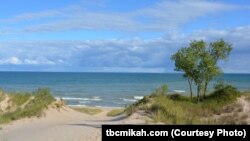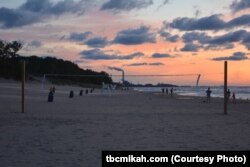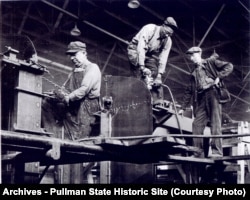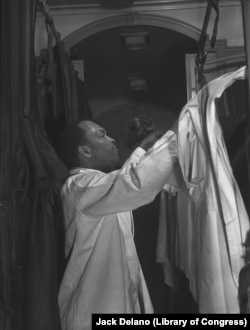In celebration of the National Park Service’s 100th anniversary, adventurer Mikah Meyer is traveling across America with the goal of visiting every one of the more than 400 sites within its jurisdiction.
The young traveler set out from Washington, D.C., in June and has already experienced dozens of sites. And VOA has been following him every step of the way.
Sand and surf
Today, we're at Indiana Dunes National Lakeshore, which stretches along 24 kilometers (15 miles) of the southern shore of Lake Michigan.
It is renowned for its beautiful sandy beaches that offer visitors many opportunities for land and water activities, with views of the Chicago skyline in nearby Illinois.
Mikah embraced the challenge of flying a kite on the windy beach but enjoyed even more watching a kiteboard enthusiast surfing along — and at one point flying over — the turbulent water.
But the coolest thing, Mikah said, was being able to see Chicago in the distance.
“You could see the Willis Tower [still commonly referred to as Sears Tower], and the John Hancock Center and a bunch of other buildings from the beach, so it was this nice juxtaposition of urbanity and communing with nature,” he said.
Being in the middle of nature while surrounded by urban development reminded him of the importance of the national parks.
“On either side of the dunes, there was some sort of industry that was spewing smoke into the air, and so it was a very poignant reminder that basically this whole beach would have looked like that had they not saved it and set it aside.”
Utopian dreams
Next stop: Chicago, where the South Side's historic district of Pullman was recently designated a national monument by President Barack Obama, who referred to it as “the heart of what would become America’s labor movement.”
Mikah explained that the 80-hectare (200-plus-acre) neighborhood was once the utopian dream of 19th-century American industrialist George Mortimer Pullman.
Pullman was known for his innovative design and manufacturing of the Pullman railroad sleeping car, which made travel on the U.S. railways a lot more luxurious and comfortable. The businessman created a “company town” where his railway employees could live and work in a safe neighborhood and enjoy a better standard of living. Many of those employees were immigrants from Scandinavia, Germany, England and Ireland.
That utopian model actually worked for about 10 years, Mikah said, "but then the U.S. hit a depression.”
Despite the sudden hardships facing his workers, “in 1893, Pullman wanted to recoup the investment he'd made into building these houses,” Mikah explained, “so he still charged people the same amount of rent.” As a result, "workers’ wages were cut [and] some lost their jobs because of the economic depression, so they couldn't afford the rent anymore. Then they went on strike.”
The 1894 railroad strike and boycott of Pullman cars was the first national strike in the U.S. and involved 150,000 people. At one point the National Guard was called in and dozens were killed in the ensuing violence.
Birth of the labor, civil rights movements
That violent conflict roiled the country, resulting in the creation of Labor Day, a federal holiday that honors working Americans. It was one of the ways President Grover Cleveland tried to appease the Pullman strikers, Mikah said.
Another result of the Pullman unrest was the formation of the first all-black labor union, the Brotherhood of Sleeping Car Porters in 1925, under the leadership of African-American civil rights leader Asa Philip Randolph. Its members were Pullman porters, men hired to work on the railway cars. After the U.S. Civil War, in the late 1860s, when newly freed slaves were looking for jobs, Pullman began hiring only African-Americans to serve as porters, a practice that continued until the 1960s.
Many believe the formation of that union paved the path for the Civil Rights and American labor movements that followed.
Mikah said it would be fascinating to see the Pullman district again in five to 10 years, once planners finish redeveloping the buildings.
The restoration of some of the important and historic buildings in the area "will hopefully help the neighborhood, because it’s on the South Side of Chicago, which is the rougher side of town.”
One of Michelle Obama's great-grandfathers was a Pullman porter. And Barack Obama spent time in the historic neighborhood in his days as a community organizer.
How fitting that the birthplace of the labor/civil rights movements played such a large role in shaping the future of our first family.
Coming attractions
In the coming days Mikah will be visiting the River Raisin National Battlefield Park (which preserves, commemorates and interprets the January 1813 battles of the War of 1812) in Monroe, Michigan.
To follow Mikah and learn more about the places he’s traveling to, he invites you to visit him on his website.















